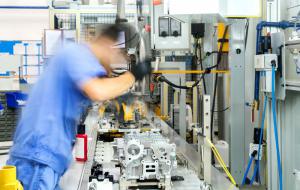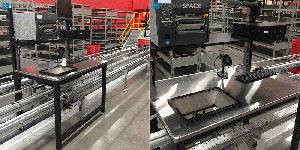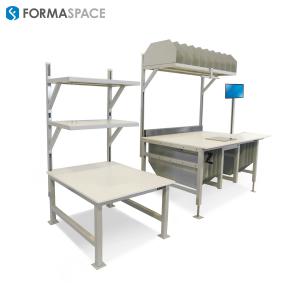How to Attract Talent to Industrial Facilities
If you’re coming up short on finding enough workers for your industrial facility, you’re not alone. Let's look at ways to attract (and retain) more workers.
AUSTIN, TEXAS, USA, January 3, 2020 /EINPresswire.com/ -- If you’re having trouble hiring a sufficient number of workers at your industrial facility, you are not alone.A recent study conducted by the consulting firm Deloitte in partnership with The Manufacturing Institute has confirmed this looming gap between the number of jobs and the number of available workers to fill them. The report projects that the manufacturing industry will create 700,000 new job positions in the coming decade; however, about 2.7 million workers are expected to retire during this time period, leading to a shortage of as many as 2 million manufacturing workers.
The potential cost of industrial facilities is large. In a study conducted by Accenture for The Manufacturing Institute, acute worker shortages could drive down the earnings of the average US manufacturer by as much as 11%.
If you haven’t done so already, now is the time to assess the projected hiring needs for your industrial facility. Can you maintain equilibrium as more and more of your Baby Boomer workers retire? Will you be able to hire enough workers to fulfill your strategic plan? What about future growth?
If you’re coming up short on finding enough workers, you’re not alone. All across the country, from Chicago to Florida and Iowa, employers across all industries are finding it difficult to fulfill their open positions.
Let’s take a look at some of the unique hiring barriers facing industrial facilities and what can be done about it.
In times past, good industrial jobs were kept in the family – sought-after jobs were often passed from one generation of family members to another; indeed, many companies boasted that they employed third or even fourth generation workers at their facilities.
But times have changed. Whether it’s due to widespread off-shoring of American manufacturing to Asia or uncertainties caused by major restructurings that took place as a result of the Great Recession that began in 2008, younger generations of workers (starting with the Millennials) have, by and large, rebuffed long-standing tradition and shunned employment opportunities at industrial facilities.
A headline in the Financial Times puts it best: US manufacturers struggle to attract ‘cool’ millennials. In the article, Patrick Bass, US chief of ThyssenKrupp, the German conglomerate, says, “in the US, an engineer usually comes out of university after five or five and a half years” and can earn an average starting salary of $45,000 to $50,000 with some debt. But “a certified welder after four years can be earning $85,000 to $100,000 a year without anywhere near the debt. But most households will still say the engineer has a successful career while the welder does not. That’s a fundamental issue we need to work on.” Despite the good salaries offered by industrial employers, ThyssenKrupp finds that many parents are actively steering their children away from manufacturing and other industrial facility jobs in favor of “clean” white-collar jobs.
But parental attitudes are not the whole story. The younger generation workers themselves seem to have adopted attitudes toward employment opportunities that are markedly different from those of their parents. The public opinion survey firm Gallup conducted an extensive representative survey of Millennials, the first generation of digital natives to enter the workforce. Gallup identified these six key attitudes toward work that differentiate Millennials from the earlier Baby Boomer generation:
Millennials don’t just work for a paycheck — they want a purpose.
Millennials are not pursuing job satisfaction — they are pursuing development.
Millennials don’t want bosses — they want coaches.
Millennials don’t want annual reviews — they want ongoing conversations.
Millennials don’t want to fix their weaknesses — they want to develop their strengths.
It’s not just my job — it’s my life.
Many of these attitudes were confirmed in a survey that Formaspace conducted in 2018. In our survey, we found that younger workers placed a far greater value on achieving an overall “Life-Work Balance” than their older peers.
As a result, the long-standing reputation of manufacturing and other industrial jobs as a place where workers perform repetitive tasks from 9 to 5 in exchange for a steady paycheck simply doesn’t appeal to enough of today’s younger job candidates.
This poses both a challenge and an opportunity for industrial manufacturing employers.
The challenge is that younger workers want to work in fields which they perceive to be more closely aligned with their values and objectives, such as employment opportunities in the high-tech sector.
But perception lags reality. More and more jobs in the industrial sector are now considered high-tech positions in their own right. The question becomes how to communicate these changes to a wider audience of potential recruits, as we’ll touch on in the next section.
Let’s take a look at six ways that American manufacturers, warehouse distribution centers, and assembly facilities can close the hiring gap.
Read more ... https://formaspace.com/articles/industrial/attract-talent-to-industrial-facilities/?utm_source=einpresswire&utm_medium=content&utm_campaign=article-031919
Mehmet Atesoglu
Formaspace
+5122792792
email us here
Volkswagen Phaeton Production
Legal Disclaimer:
EIN Presswire provides this news content "as is" without warranty of any kind. We do not accept any responsibility or liability for the accuracy, content, images, videos, licenses, completeness, legality, or reliability of the information contained in this article. If you have any complaints or copyright issues related to this article, kindly contact the author above.




